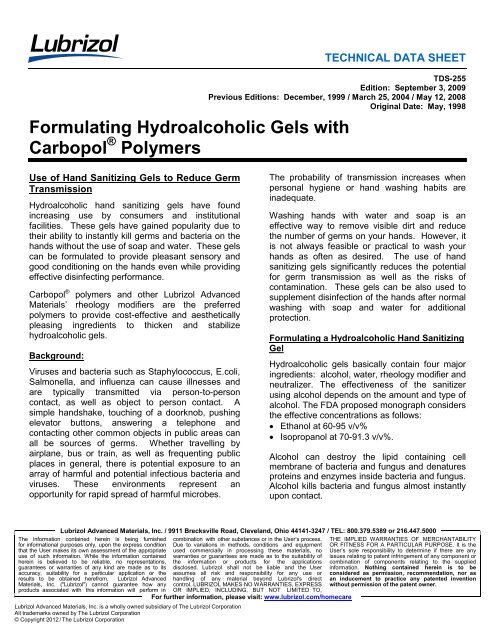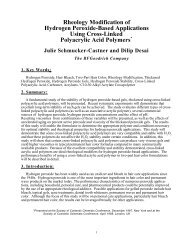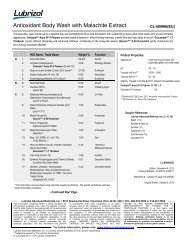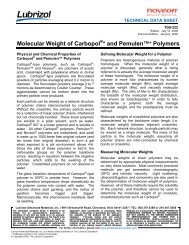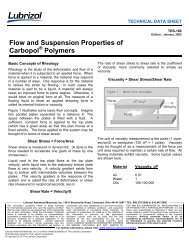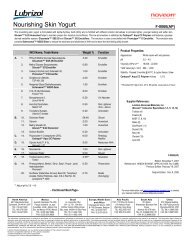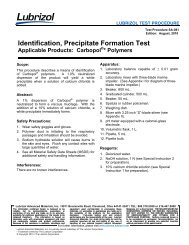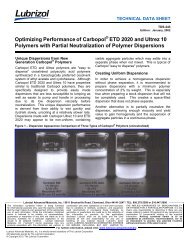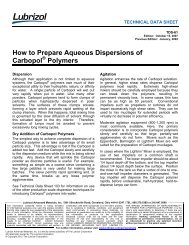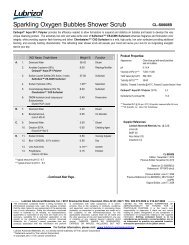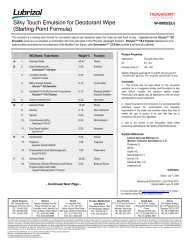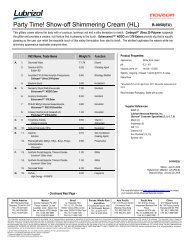Formulating Hydroalcoholic Gels with Carbopol Technical ... - Lubrizol
Formulating Hydroalcoholic Gels with Carbopol Technical ... - Lubrizol
Formulating Hydroalcoholic Gels with Carbopol Technical ... - Lubrizol
Create successful ePaper yourself
Turn your PDF publications into a flip-book with our unique Google optimized e-Paper software.
TECHNICAL DATA SHEET<br />
TDS-255<br />
Edition: September 3, 2009<br />
Previous Editions: December, 1999 / March 25, 2004 / May 12, 2008<br />
Original Date: May, 1998<br />
<strong>Formulating</strong> <strong>Hydroalcoholic</strong> <strong>Gels</strong> <strong>with</strong><br />
<strong>Carbopol</strong> ® Polymers<br />
Use of Hand Sanitizing <strong>Gels</strong> to Reduce Germ<br />
Transmission<br />
<strong>Hydroalcoholic</strong> hand sanitizing gels have found<br />
increasing use by consumers and institutional<br />
facilities. These gels have gained popularity due to<br />
their ability to instantly kill germs and bacteria on the<br />
hands <strong>with</strong>out the use of soap and water. These gels<br />
can be formulated to provide pleasant sensory and<br />
good conditioning on the hands even while providing<br />
effective disinfecting performance.<br />
<strong>Carbopol</strong> ® polymers and other <strong>Lubrizol</strong> Advanced<br />
Materials’ rheology modifiers are the preferred<br />
polymers to provide cost-effective and aesthetically<br />
pleasing ingredients to thicken and stabilize<br />
hydroalcoholic gels.<br />
Background:<br />
Viruses and bacteria such as Staphylococcus, E.coli,<br />
Salmonella, and influenza can cause illnesses and<br />
are typically transmitted via person-to-person<br />
contact, as well as object to person contact. A<br />
simple handshake, touching of a doorknob, pushing<br />
elevator buttons, answering a telephone and<br />
contacting other common objects in public areas can<br />
all be sources of germs. Whether travelling by<br />
airplane, bus or train, as well as frequenting public<br />
places in general, there is potential exposure to an<br />
array of harmful and potential infectious bacteria and<br />
viruses. These environments represent an<br />
opportunity for rapid spread of harmful microbes.<br />
The probability of transmission increases when<br />
personal hygiene or hand washing habits are<br />
inadequate.<br />
Washing hands <strong>with</strong> water and soap is an<br />
effective way to remove visible dirt and reduce<br />
the number of germs on your hands. However, it<br />
is not always feasible or practical to wash your<br />
hands as often as desired. The use of hand<br />
sanitizing gels significantly reduces the potential<br />
for germ transmission as well as the risks of<br />
contamination. These gels can be also used to<br />
supplement disinfection of the hands after normal<br />
washing <strong>with</strong> soap and water for additional<br />
protection.<br />
<strong>Formulating</strong> a <strong>Hydroalcoholic</strong> Hand Sanitizing<br />
Gel<br />
<strong>Hydroalcoholic</strong> gels basically contain four major<br />
ingredients: alcohol, water, rheology modifier and<br />
neutralizer. The effectiveness of the sanitizer<br />
using alcohol depends on the amount and type of<br />
alcohol. The FDA proposed monograph considers<br />
the effective concentrations as follows:<br />
• Ethanol at 60-95 v/v%<br />
• Isopropanol at 70-91.3 v/v%.<br />
Alcohol can destroy the lipid containing cell<br />
membrane of bacteria and fungus and denatures<br />
proteins and enzymes inside bacteria and fungus.<br />
Alcohol kills bacteria and fungus almost instantly<br />
upon contact.<br />
<strong>Lubrizol</strong> Advanced Materials, Inc. / 9911 Brecksville Road, Cleveland, Ohio 44141-3247 / TEL: 800.379.5389 or 216.447.5000<br />
The information contained herein is being furnished combination <strong>with</strong> other substances or in the User’s process. THE IMPLIED WARRANTIES OF MERCHANTABILITY<br />
for informational purposes only, upon the express condition Due to variations in methods, conditions and equipment OR FITNESS FOR A PARTICULAR PURPOSE. It is the<br />
that the User makes its own assessment of the appropriate used commercially in processing these materials, no User’s sole responsibility to determine if there are any<br />
use of such information. While the information contained warranties or guarantees are made as to the suitability of issues relating to patent infringement of any component or<br />
herein is believed to be reliable, no representations, the information or products for the applications combination of components relating to the supplied<br />
guarantees or warranties of any kind are made as to its disclosed. <strong>Lubrizol</strong> shall not be liable and the User information. Nothing contained herein is to be<br />
accuracy, suitability for a particular application or the assumes all risk and responsibility for any use or considered as permission, recommendation, nor as<br />
results to be obtained herefrom. <strong>Lubrizol</strong> Advanced handling of any material beyond <strong>Lubrizol</strong>'s direct an inducement to practice any patented invention<br />
Materials, Inc. ("<strong>Lubrizol</strong>") cannot guarantee how any control. LUBRIZOL MAKES NO WARRANTIES, EXPRESS <strong>with</strong>out permission of the patent owner.<br />
products associated <strong>with</strong> this information will perform in OR IMPLIED, INCLUDING, BUT NOT LIMITED TO,<br />
For further information, please visit: www.lubrizol.com/homecare<br />
<strong>Lubrizol</strong> Advanced Materials, Inc. is a wholly owned subsidiary of The <strong>Lubrizol</strong> Corporation<br />
All trademarks owned by The <strong>Lubrizol</strong> Corporation<br />
© Copyright 2012 / The <strong>Lubrizol</strong> Corporation
<strong>Lubrizol</strong> Advanced Materials’ rheology modifiers are<br />
efficient ingredients to provide thickening,<br />
stabilization and suspension of these types of<br />
formulations. <strong>Carbopol</strong> polymers are the preferred<br />
polymers to provide cost effective and aesthetically<br />
pleasing hand sanitizing gels. The use of <strong>Carbopol</strong><br />
polymers will create thick clear gels that will prevent<br />
dripping and will maximize contact of alcohol on the<br />
skin for optimum performance.<br />
Benefits<br />
• Quickly kills bacteria when water is not available.<br />
• Quickly evaporates on application requiring no<br />
need for rinsing or drying of the hands.<br />
• Consumer convenience over ordinary hand<br />
washing <strong>with</strong> soap and water.<br />
• Emollients, botanical extracts, moisturizers and<br />
fragrances can all be incorporated and are<br />
compatible -- thus helping to provide additional<br />
functional benefits such as conditioning.<br />
TDS-255<br />
<strong>Formulating</strong> <strong>Hydroalcoholic</strong> <strong>Gels</strong> <strong>with</strong> <strong>Carbopol</strong> ® Polymers<br />
Page 2 of 6<br />
Polymer Selection<br />
Although all <strong>Carbopol</strong> polymers can thicken<br />
hydroalcoholic systems, several grades offer<br />
advantages such as higher clarity, better<br />
efficiency, ease of handling and better overall<br />
aesthetics for hand sanitizing gels. All three of our<br />
<strong>Carbopol</strong> Ultrez polymers are good rheology<br />
modifiers for these gels. A typical hand sanitizing<br />
gel contains less than 40 wt% deionized water.<br />
Due to this constraint, the low dispersion viscosity,<br />
as well as the processing ease, makes the<br />
<strong>Carbopol</strong> Ultrez polymers well-suited for these<br />
types of formulations as compared to the more<br />
traditional polymer grades. The following table will<br />
assist in polymer selection.<br />
<strong>Carbopol</strong> ® Polymer Ultrez 10 Ultrez 21 Ultrez 20 980 940<br />
HSG Viscosity*, >0.2 wt% ��� ��� �� ��� ��<br />
Clarity �� �� ��� � �<br />
Electrolyte Tolerance � �� ��� � �<br />
Smoothness after use ��� ��� ��� �� ��<br />
Ease of dispersion ��� ��� ��� � �<br />
Balling or Pilling** � �� ��� � ��<br />
��� Preferred � Lower performance<br />
*The HSG Viscosity references the formulation viscosity of the Hand Sanitizing Gel shown in table below<br />
**The more checks the less pilling of system occurs<br />
Screening Formulation for <strong>Carbopol</strong> Polymer Comparison<br />
Use Level of <strong>Carbopol</strong> ® Polymer 0.1 wt% 0.2 wt% 0.3 wt% 0.4 wt% 0.5 wt%<br />
Deionized Water (wt%) 39.8 39.6 39.4 39.2 39.0<br />
Ethanol (wt%) 60.0 60.0 60.0 60.0 60.0<br />
TEA (wt%) 0.1 0.2 0.3 0.4 0.5
Clarity Results: %Transmittance at 420 nm<br />
Clarity, %T<br />
100<br />
90<br />
80<br />
70<br />
60<br />
50<br />
40<br />
30<br />
20<br />
10<br />
0<br />
TDS-255<br />
<strong>Formulating</strong> <strong>Hydroalcoholic</strong> <strong>Gels</strong> <strong>with</strong> <strong>Carbopol</strong> ® Polymers<br />
Page 3 of 6<br />
Clarity of Hand Sanitizing <strong>Gels</strong><br />
0.10% 0.30% 0.50%<br />
Polymer Concentration, wt% TS<br />
Viscosity Results: Brookfield RVT, 20 rpm @ 25°C<br />
Viscosity, mPa•s<br />
25,000<br />
20,000<br />
15,000<br />
10,000<br />
5,000<br />
0<br />
Viscosity of Hand Sanitizing <strong>Gels</strong><br />
0.10% 0.30% 0.50%<br />
Polymer Concentration, wt% TS<br />
<strong>Carbopol</strong>® 940 Polymer<br />
<strong>Carbopol</strong>® 980 Polymer<br />
<strong>Carbopol</strong>® Ultrez 10<br />
Polymer<br />
<strong>Carbopol</strong>® Ultrez 21<br />
Polymer<br />
<strong>Carbopol</strong>® Ultrez 20<br />
Polymer<br />
<strong>Carbopol</strong>® 940 Polymer<br />
<strong>Carbopol</strong>® 980 Polymer<br />
<strong>Carbopol</strong>® Ultrez 10<br />
Polymer<br />
<strong>Carbopol</strong>® Ultrez 21<br />
Polymer<br />
<strong>Carbopol</strong>® Ultrez 20<br />
Polymer
Neutralization of <strong>Carbopol</strong> Polymers in Hand<br />
Sanitizing <strong>Gels</strong><br />
The key to formulating a hydroalcoholic gel <strong>with</strong><br />
<strong>Carbopol</strong> polymers is choosing the correct<br />
neutralizing agent. Many neutralizing agents<br />
commonly used to neutralize <strong>Carbopol</strong> polymers in<br />
aqueous systems do not work in hydroalcoholic<br />
TDS-255<br />
<strong>Formulating</strong> <strong>Hydroalcoholic</strong> <strong>Gels</strong> <strong>with</strong> <strong>Carbopol</strong> ® Polymers<br />
Page 4 of 6<br />
systems. There are amine solubility limitations <strong>with</strong><br />
high alcohol, low water containing systems. The<br />
solubility of the <strong>Carbopol</strong> polymer salt changes as the<br />
alcohol level is increased making the choice of<br />
neutralizing agents important. Different choices are<br />
provided as a guideline for the different alcohol type<br />
and level.<br />
Neutralizing Agent Versus Alcohol Level<br />
Maximum<br />
Alcohol Neutralization Ratio*<br />
Trade Name INCI Name Manufacturer Level Base/ <strong>Carbopol</strong> ® Polymer<br />
NaOH (18%) Sodium Hydroxide 20% 2.3/1.0<br />
KOH (18%)<br />
Potassium<br />
Hydroxide<br />
30% 2.7/1.0<br />
TEA (99%) Triethanolamine 60% 1.5/1.0<br />
Tris Amino (40%)** Tromethamine Angus / Dow 60% 3.3/1.0<br />
AMP ® Ultra PC2000<br />
Neutrol ® TE<br />
Aminomethyl<br />
Propanol<br />
Tetrahydroxypropyl<br />
Ethylenediamine<br />
Angus / Dow 80% 0.9/1.0<br />
BASF<br />
90% 2.3/1.0<br />
Triisopropanolamine Triisopropanolamine Dow 90% 1.5/1.0<br />
* Ratio values indicated above are for mucilages. For the 60% hydroalcoholic gel, divide the base ratio amount by 1.25<br />
**NOTE: The 40% solution should be made from the Tris Amino crystal provided by the manufacturer. We do not recommend using<br />
the predispersed solution produced by the manufacturer due to its high impurity content<br />
Check your local regulations while selecting the appropriate neutralizing amine since there are often specific<br />
guidelines on the type of amine and impurity level in the amine for these types of formulations.<br />
Modification and Formula Enhancements for <strong>Hydroalcoholic</strong> <strong>Gels</strong><br />
Common Formulation additives for Hand Sanitizing <strong>Gels</strong><br />
Water soluble emollients<br />
Emollients<br />
Fragrance<br />
<strong>Carbopol</strong> ® polymers<br />
Rheology modifier<br />
Alcohol<br />
Disinfecting agent<br />
Specialty Silicones<br />
Botanical Actives
Formulation and Manufacturing Guidelines<br />
• Typical hand sanitizing gels contain less that 40<br />
wt% water. Due to this formulation constraint, a<br />
common concern is how to effectively incorporate<br />
the <strong>Carbopol</strong> polymer. The general methods are<br />
outlined as follows, dependent on your choice of<br />
polymer:<br />
Direct Method: The direct method is the traditional<br />
method for dispersing <strong>Carbopol</strong> polymers.<br />
<strong>Carbopol</strong> Ultrez Polymers: This method is made<br />
easy <strong>with</strong> <strong>Carbopol</strong> Ultrez polymers since you simply<br />
sprinkle the polymer on the surface of the water.<br />
Allow the polymer to self wet and then begin<br />
agitation. The general procedure is described as<br />
follows:<br />
1. Disperse the polymer into the water. Mix until<br />
smooth to insure a lump free dispersion is<br />
obtained.<br />
2. Slowly add the alcohol <strong>with</strong> agitation and mix until<br />
homogeneous.<br />
3. Add emollients if desired. Keep in mind that the<br />
order of addition may be critical to maintain<br />
product clarity. See “Adding Emollients” for<br />
further information.<br />
4. Add the appropriate neutralizing agent <strong>with</strong> gentle<br />
sweeping agitation and mix until smooth.<br />
NOTE: If production equipment constraints require<br />
the water and alcohol to be combined before the<br />
dispersion of polymer, the <strong>Carbopol</strong> Ultrez polymers<br />
must be dispersed like a traditional polymer. The<br />
<strong>Carbopol</strong> Ultrez grade polymers will not self wet in a<br />
solution of water and alcohol.<br />
<strong>Carbopol</strong> Traditional Grade Polymers: These<br />
polymers can be dispersed in either the water or<br />
alcohol/water mixture. The polymer will swell more<br />
slowly when added to the alcohol/water mixture, so<br />
care must be taken to avoid the clumping and<br />
skinning of the polymer during the dispersion<br />
process.<br />
1. Carefully disperse the polymer in the water or<br />
water/alcohol mixture <strong>with</strong> good agitation. High<br />
mixing speeds are generally preferred as it<br />
prevents agglomeration of the polymer on the<br />
surface of the water. Mix until the polymer is<br />
hydrated and the dispersion is smooth and free of<br />
lumps.<br />
TDS-255<br />
<strong>Formulating</strong> <strong>Hydroalcoholic</strong> <strong>Gels</strong> <strong>with</strong> <strong>Carbopol</strong> ® Polymers<br />
Page 5 of 6<br />
2. Add the alcohol <strong>with</strong> slow mixing to de-aerate the<br />
formulation if it was not included in Step 1.<br />
3. Add emollients if desired. Keep in mind that the<br />
order of addition may be critical to maintain<br />
product clarity. See “Adding Emollients” for<br />
further information.<br />
4. Add the appropriate neutralizing agent <strong>with</strong> gentle<br />
sweeping agitation and mix until smooth.<br />
• Water Source: Use deionized water. <strong>Carbopol</strong><br />
polymers are sensitive to hard water ions,<br />
therefore, the clarity and viscosity may be<br />
negatively affected if regular tap water is used. If<br />
deionized water is unavailable, add a chelating<br />
agent such as tetrasodium EDTA at a level of<br />
about 0.05-0.10% (wt/wt%).<br />
• Adding Emollients: Several commercially<br />
available emollients can be added to the hand<br />
sanitizing gel to compensate for removal of oils<br />
on the hands by the alcohol. The following watersoluble<br />
emollients can be added directly to the<br />
water and polymer dispersion or just before<br />
neutralization. The use of these emollients from<br />
0.3-0.5 wt% addition will not impact the final<br />
product clarity.<br />
Trade Name INCI Name<br />
Glucam E-20 Humectant Methyl Gluceth-20<br />
Glucam E-10 Humectant Methyl Gluceth-10<br />
SilSense Copolyol-1 Silicone PEG-33 and PEG-8<br />
Dimethicone and PEG-14<br />
SilSense SW-12 Silicone Ester Dimethicone PEG-7 Cocoate<br />
Hydramol PGPL Emollient PEG/PPG-8/3 Laurate<br />
Hydramol PGDS Emollient PEG-90 Diisostearate<br />
The Hydramol emollients can be added at use<br />
levels from 0.5-3.0 wt% and still maintain good clarity<br />
in the system.<br />
The use of other emollients may impact the final<br />
product clarity depending on the solubility profile of<br />
that particular emollient. Other emollients, such as<br />
isopropyl myristate, may need to be added to the<br />
alcohol and the water/polymer dispersion added to<br />
the alcohol/emollient phase to maintain final product<br />
clarity.
Clarity (% Transmission @ 420 nm)<br />
All polymers suggested for this application have<br />
excellent clarity in hydroalcoholic systems. Clarity<br />
can be affected by many factors including dispersion<br />
techniques, water source, emollient content,<br />
formulation pH, type and level of fragrance and/or<br />
dye addition. <strong>Hydroalcoholic</strong> gels made <strong>with</strong><br />
<strong>Carbopol</strong> polymers typically have clarity of 92-98 %T.<br />
To obtain optimum clarity we recommend the<br />
following:<br />
• Use deionized water.<br />
• Use Direct Method for Polymer Dispersion.<br />
When using self-wetting polymers they should be<br />
dispersed in water, not a water/alcohol mixture.<br />
Reference TDS-103 for details on dispersing<br />
traditional grade <strong>Carbopol</strong> polymers.<br />
• Choose the correct neutralizing amine. It is<br />
important to insure that the neutralizing amine is<br />
compatible <strong>with</strong> the alcohol. Reference guidelines<br />
provided.<br />
• For maximum clarity, target appropriate pH.<br />
We recommend the following pH:<br />
� For <strong>Carbopol</strong> polymers such as Ultrez 10, 940<br />
and 980, the optimum pH is typically around<br />
7.0.<br />
� For <strong>Carbopol</strong> Ultrez 21 and Ultrez 20 polymers,<br />
the optimum pH is 5.8-6.3.<br />
� We recommend evaluating various pH levels<br />
and neutralizing amines to determine which<br />
combination provides the best clarity for your<br />
specific formulation.<br />
• Choose a water-soluble emollient. Optimize use<br />
level to provide best balance of clarity and<br />
conditioning aesthetics.<br />
• Use water soluble dyes. Examples of appropriate<br />
colors are D&C Red #33, D&C Green #5,<br />
and FD&C Blue #1. Dyes supplied as powders<br />
should be made into dilute (1-3 wt%) solutions and<br />
added at the end of the formulation.<br />
• Addition of oil soluble fragrances. These<br />
ingredients should be post added at low levels. A<br />
solubilizer such as Polysorbate 20 at about 0.2<br />
wt% may be necessary to insure good clarity.<br />
• Filtration of end product will maximize final<br />
clarity.<br />
TDS-255<br />
<strong>Formulating</strong> <strong>Hydroalcoholic</strong> <strong>Gels</strong> <strong>with</strong> <strong>Carbopol</strong> ® Polymers<br />
Page 6 of 6<br />
Frequently Asked Questions<br />
• Hand hygiene in healthcare settings.<br />
The US Center for Disease Control (CDC) has<br />
issued guidelines for hand hygiene in healthcare<br />
settings in order to more effectively reduce the<br />
spread of hospital-based infections by healthcare<br />
professionals. The CDC’s guideline, released in<br />
October 2002, strongly recommends alcoholbased<br />
hand sanitizers as the primary method of<br />
hand hygiene among healthcare professionals<br />
when hands are not visibly soiled. The World<br />
Health Organization (WHO) issued “Hand Hygiene<br />
in Health Care Guidelines” in May of 2009.<br />
The following is a link to that document:<br />
http://whqlibdoc.who.int/publications/2009/978924<br />
1597906_eng.pdf<br />
• Safety of direct food contact after using an<br />
alcoholic hand sanitizer?<br />
Using an alcoholic hand sanitizing gel is generally<br />
considered safe. In Canada, workers in the food<br />
industry are allowed to use alcoholic hand<br />
sanitizing gels since they have been approved by<br />
Health Canada. These systems are listed by the<br />
Canadian Food Inspections Agency as acceptable<br />
non-food chemical products. In the food service<br />
industry, an alcohol sanitizer is considered helpful<br />
as an extra hand disinfecting step after washing of<br />
hands <strong>with</strong> soap and water. The FDA has approved<br />
<strong>Carbopol</strong> polymers for indirect food contact when<br />
used in hand sanitizers up to 0.5 wt%.<br />
• Protection in Schools.<br />
According to a study issued in October of 2000 in<br />
The American Journal of Infection Control, the use<br />
of hand sanitizing gels was shown to decrease<br />
absenteeism due to illness among elementary<br />
school students by 20%.<br />
• Acceptance of Hand Sanitizing <strong>Gels</strong>.<br />
According to a study published in the July, 2000<br />
issue of Infection Control and Hospital<br />
Epidemiology, use of a Hand Sanitizing Gel is<br />
accepted by healthcare workers and does not<br />
result in skin irritation and dryness when<br />
compared to frequent soap and water hand<br />
washing.<br />
• Regulations.<br />
Hand Sanitizing <strong>Gels</strong> may be regulated as drug<br />
products. Review your country’s regulations to<br />
insure compliance.


